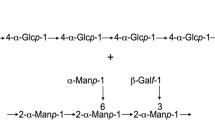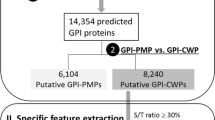Abstract
Fluorescent-labeled invertase, a hyperglycosylated mannoprotein from Saccharomyces cerevisiae, was found to bind to Lactococcus lactis IL1403 at acidic pH. Proteins on the cell wall of the bacterium affinity-purified using invertase as a ligand were identified to be heat shock proteins such as DnaK and GroEL and glycolytic enzymes such as pyruvate kinase and glyceraldehyde-3-phosphate dehydrogenase. DnaK bound to both the bacterium and yeast at pH 4 and aggregated them at above 0.1 mg/ml, whereas no significant difference between the circular dichroism spectra of DnaK at pH 4 and 7 was observed. These results indicate that the cytosolic proteins, including DnaK displayed on the cell wall, cause the lactic acid bacterium to adhere to the yeast.





Similar content being viewed by others
References
Adlerberth I, Ahrne S, Johansson ML, Molin G, Hanson LA, Wold AE (1996) A mannose-specific adherence mechanism in Lactobacillus plantarum conferring binding to the human colonic cell line HT-29. Appl Environ Microbiol 62:2244–2251
Barbosa MS, Bao SN, Andreotti PF, de Faria FP, Felipe MS, dos Santos Feitosa L, Mendes-Giannini MJ, Soares CM (2006) Glyceraldehyde-3-phosphate dehydrogenase of Paracoccidioides brasiliensis is a cell surface protein involved in fungal adhesion to extracellular matrix proteins and interaction with cells. Infect Immun 74:382–389
Bergonzelli GE, Granato D, Pridmore RD, Marvin-Guy LF, Donnicola D, Corthesy-Theulaz IE (2006) GroEL of Lactobacillus johnsonii La1 (NCC 533) is cell surface associated: potential role in interactions with the host and the gastric pathogen Helicobacter pylori. Infect Immun 74:425–434
Bolotin A, Wincker P, Mauger S, Jaillon O, Malarme K, Weissenbach J, Ehrlich SD, Sorokin A (2001) The complete genome sequence of the lactic acid bacterium Lactococcus lactis ssp. lactis IL1403. Genome Res 11:731–753
Cheirsilp B, Shimizu H, Shioya S (2001) Modelling and optimization of environmental conditions for kefiran production by Lactobacillus kefiranofaciens. Appl Microbiol Biotechnol 57:639–646
Cheirsilp B, Shimizu H, Shioya S (2003a) Enhanced kefiran production by mixed culture of Lactobacillus kefiranofaciens and Saccharomyces cerevisiae. J Biotechnol 100:43–53
Cheirsilp B, Shimizu H, Shioya S (2003b) Interactions between Lactobacillus kefiranofaciens and Saccharomyces cerevisiae in mixed culture for kefiran production. J Biosci Bioeng 93:279–284
Cheirsilp B, Shimizu H, Shioya S (2007) Kinetic modeling of kefiran production in mixed culture of Lactobacillus kefiranofaciens and Saccharomyces cerevisiae. Process Biochem 42:570–579
Colonna WJ, Cano FR, Lampen JO (1975) Microheterogeneity in yeast invertase. Biochim Biophys Acta 386:293–300
Corsetti A, Rossi J, Gobbetti M (2001) Interactions between yeasts and bacteria in the smear surface-ripened cheeses. Int J Food Microbiol 69:1–10
Do TM, Plockova MI, Chumchalova JA (2001) Lactococcus lactis subsp. lactis LTM 32, a new bacteriocin-producing strain isolated from Vietnamese fermented milk. Czech J Food Sci 19:171–176
Ensgraber M, Loos M (1992) A 66-kilodalton heat shock protein of Salmonella typhimurium is responsible for binding of the bacterium to intestinal mucus. Infect Immun 60:3072–3078
Garduno RA, Garduño E, Hoffman PS (1988) Surface-associated Hsp60 chaperonin of Legionella pneumophila mediates invasion in a HeLa cell model. Infect Immun 66:4602–4610
Gill SC, von Hippel PH (1989) Calculation of protein extinction coefficients from amino acid sequence data. Anal Biochem 182:319–326
Gobbetti M (1998) The sourdough microflora: interactions of lactic acid bacteria and yeasts. Trends Food Sci Technol 9:267–274
Gomi M, Sonoyama M, Mitaku S (2004) High performance system for signal peptide prediction: SOSUIsignal. Chem-Bio Info J 4:142–147
Goulhen F, Hafezi A, Uitto VJ, Hinode D, Nakamura R, Grenier D, Mayrand D (1998) Subcellular localization and cytotoxic activity of the GroEL-like protein isolated from Actinobacillus actinomycetemcomitans. Infect Immun 66:5307–5313
Granato D, Bergonzelli GE, Pridmore RD, Marvin-Guy LF, Rouvet M, Corthesy-Theulaz IE (2004) Cell surface-associated elongation factor Tu mediates the attachment of Lactobacillus johnsonii NCC 533 (La1) to human intestinal cells and mucins. Infect Immun 72:2160–2169
Gusils C, Palacios J, Gonzalez S, Oliver G (1999) Lectin-like protein fractions in lactic acid bacteria isolated from chickens. Biol Pharm Bull 22:11–15
Hennequin C, Porcheray F, Waligora-Dupriet AJ, Collignon A, Barc MC, Bourlioux P, Karjalainen T (2001) GroEL (Hsp60) of Clostridium difficile is involved in cell adherence. Microbiology 147:87–96
Huesca MC, Borgia S, Hoffman P, Lingwood CA (1996) Acidic pH changes receptor binding specificity of Helicobacter pylori: a binary adhesion model in which surface heat shock (stress) proteins mediate sulfatide recognition in gastric colonization. Infect Immun 64:2643–2648
Huesca MC, Goodwin A, Bhagwansingh A, Hoffman P, Lingwood CA (1998) Characterization of an acidic-pH-inducible stress protein (hsp70), a putative sulfatide binding adhesin, from Helicobacter pylori. Infect Immun 66:4061–4067
Jesus MC, Urban AA, Marasigan ME, Barnett Foster DE (2005) Acid and bile-salt stress of enteropathogenic Escherichia coli enhances adhesion to epithelial cells and alters glycolipid receptor binding specificity. J Infect Dis 192:1430–1440
Kawarai T, Furukawa S, Ogihara H, Yamasaki M (2007) Mixed-species biofilm formation by lactic acid bacteria and rice wine yeasts. Appl Environ Microbiol 73:4673–4676
Kelly P, Maguire PB, Bennett M, Fitzgerald DJ, Edwards RJ, Thiede B, Treumann A, Collins JK, O’Sullivan GC, Shanahan F, Dunne C (2005) Correlation of probiotic Lactobacillus salivarius growth phase with its cell wall-associated proteome. FEMS Microbiol Lett 252:153–159
Kinoshita H, Uchida H, Kawai Y, Kawasaki T, Wakahara N, Matsuo H, Watanabe M, Kitazawa H, Ohnuma S, Miura K, Horii A, Saito T (2008) Cell surface Lactobacillus plantarum LA 318 glyceraldehyde-3-phosphate dehydrogenase (GAPDH) adheres to human colonic mucin. J Appl Microbiol 104:1667–1674
Lehle L, Cohen RE, Ballou CE (1979) Carbohydrate structure of yeast invertase. Demonstration of a form with only core oligosaccharides and a form with completed polysaccharide chains. J Biol Chem 254:12209–12218
Murooka Y, Yamashita M (2008) Traditional healthful fermented products of Japan. J Ind Microbiol Biotechnol 35:791–798
Narvhusa JA, Gadagab TH (2003) The role of interaction between yeasts and lactic acid bacteria in African fermented milk. Int J Food Microbiol 86:51–60
Peng X, Sun J, Iserentant D, Michiels C, Verachtert H (2001) Flocculation and coflocculation of bacteria by yeasts. Appl Microbiol Biotechnol 55:777–781
Shimizu H, Mizuguchi T, Tanaka E, Shioya S (1999) Nisin production by a mixed-culture system consisting of Lactococcus lactis and Kluyveromyces marxianus. Appl Environ Microbiol 65:3134–3141
Tada S, Katakura Y, Ninomiya K, Shioya S (2007) Fed-batch coculture of Lactobacillus kefiranofaciens with Saccharomyces cerevisiae for effective production of kefiran. J Biosci Bioeng 103:557–562
Tallon R, Arias S, Bressollier P, Urdaci MC (2007) Strain- and matrix-dependent adhesion of Lactobacillus plantarum is mediated by proteinaceous bacterial compounds. J Appl Microbiol 102:442–451
Williams RS, Trumbly RJ, MacColl R, Trimble RB, Maley F (1985) Comparative properties of amplified external and internal invertase from the yeast SUC2 gene. J Biol Chem 260:13334–13341
Author information
Authors and Affiliations
Corresponding author
Rights and permissions
About this article
Cite this article
Katakura, Y., Sano, R., Hashimoto, T. et al. Lactic acid bacteria display on the cell surface cytosolic proteins that recognize yeast mannan. Appl Microbiol Biotechnol 86, 319–326 (2010). https://doi.org/10.1007/s00253-009-2295-y
Received:
Revised:
Accepted:
Published:
Issue Date:
DOI: https://doi.org/10.1007/s00253-009-2295-y




